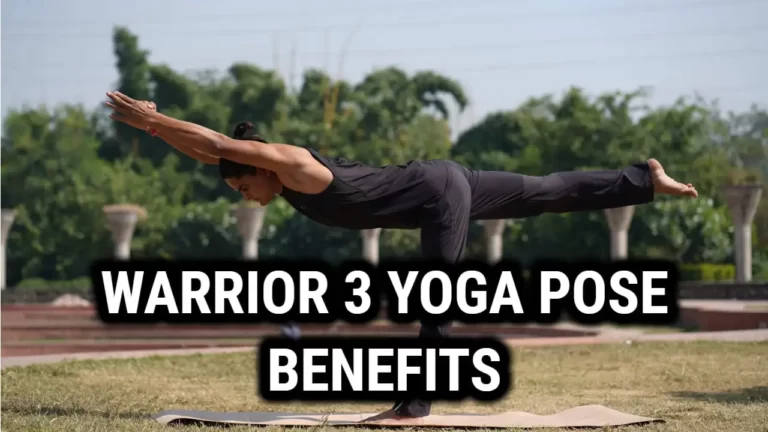Yoga for Sprained Ankle: Benefits And Poses

A common condition called an ankle sprain happens when the ligaments holding the ankle bones together are stretched or torn. No of their age or amount of physical activity, it can happen to anyone.
Mild to severe ankle sprains can result in discomfort, edoema, and trouble moving around or standing. Fortunately, yoga can help increase circulation, flexibility, and strength in the ankle and surrounding muscles, which can help treat and prevent ankle sprains.
Causes and Symptoms of Ankle Sprains
Ankle sprains can occur for a variety of reasons, such as:
- Stepping on an uneven surface
- Falling
- Rolling the ankle
- Twisting the ankle
Symptoms of an ankle sprain can vary depending on the severity of the injury. Some common symptoms include:
- Pain and tenderness
- Swelling
- Bruising
- Difficulty walking or standing
- Stiffness
There are 3 types of ankle sprains, which are determined by the severity of the injury:
- Grade 1: Mild sprain, where the ligament is stretched but not torn
- Grade 2: Moderate sprain, where the ligament is partially torn
- Grade 3: Severe sprain, where the ligament is completely torn
Benefits of Yoga for Sprained Ankle
Yoga helps increase circulation, flexibility, and strength in the ankle and surrounding muscles, which can help treat and prevent ankle sprains. The following are some advantages of yoga for ankle sprains:
Improved circulation
Yoga helps increase blood flow to the muscles around the ankle, which can assist to lessen pain and facilitate healing. Yoga positions that promote easier blood and lymphatic fluid flow, like legs up the wall, can also help reduce swelling.
Increased Flexibility
Yoga can assist increase the ankle’s flexibility and the muscles around it, which helps lower the risk of subsequent ankle sprains. Yoga poses that stretch the calves and hamstrings can assist increase ankle flexibility. One such practise is the seated forward bend.
Strengthening of the muscles around the ankle
Yoga can assist the ankle and its supporting muscles become stronger, which helps lower the risk of future ankle sprains. Yoga exercises that strengthen the ankles, legs, and hips include the warrior II stance.
Reduced inflammation
Yoga can aid in reducing ankle and surrounding muscle inflammation, which can lessen discomfort and encourage healing. By boosting blood flow and lymphatic drainage, certain yoga poses, including the reclining hand-to-big-toe stance, might help relieve inflammation.
Reduced pain and stiffness
Yoga can aid in easing discomfort and stiffness in the ankle and surrounding muscles, enhancing mobility and aiding in the healing process. Yoga poses like the tree pose can aid with balance and stability, which eases ankle stiffness and pain.
Yoga Poses for Ankle Sprains
When practicing yoga with an ankle sprain, it is important to start slowly and modify poses as necessary. Here are some gentle, moderate, and advanced yoga poses that can help treat and prevent ankle sprains:
Gentle yoga poses for ankle sprains
These gentle yoga poses can help improve ankle mobility without putting too much stress on the ankle:
Reclining hand-to-big-toe pose
This pose can help reduce inflammation and improve circulation in the ankle:
- Lie on your back with your legs extended.
- Bend your right knee and bring your right foot towards your buttocks.
- Loop a strap around the ball of your right foot and hold onto the ends of the strap with both hands.
- Straighten your right leg and stretch your foot.
- Hold for 30-60 seconds, then release and repeat on the other side.
Legs up the wall pose
This pose can help reduce swelling and improve circulation in the ankle:
- Lie on your back with your hips close to a wall.
- Extend your legs up the wall, with your heels resting against the wall.
- Relax your arms by your sides and breathe deeply.
- Hold for 5-10 minutes, then release.
Moderate yoga poses for ankle sprains
These moderate yoga poses can help improve ankle strength and flexibility:
Downward-facing dog pose
This pose can help stretch the calves and hamstrings, which can improve ankle flexibility:
- Start on your hands and knees, with your hands shoulder-width apart and your knees hip-width apart.
- Lift your hips up and back, straightening your arms and legs.
- Keep your heels towards the ground and lift your back up.
- Hold for 5-10 breaths, then release.
Warrior II pose
This pose can help strengthen the ankles, legs, and hips:
- Start in a lunge position, with your right foot ahead and your left foot back.
- Turn your left foot out 90 degrees and bring your arms out to the sides, parallel to the ground.
- Bend your right knee and square your hips towards the front of the mat.
- Hold for 5-10 breaths, then release and repeat on the other side.
Advanced yoga poses for ankle sprains
These advanced yoga poses should only be practiced if you have fully healed from your ankle sprain and have the strength and flexibility to do so:
Half moon pose
This pose can help improve balance and strengthen the ankles, legs, and hips:
- Start in a lunge position, with your right foot forward and your left foot back.
- Place your right hand on the ground, about a foot in front of your right foot.
- Lift your left leg up and straighten it, bringing your left hand to your hip.
- Stack your left hip on top of your right hip and gaze up towards your left hand.
- Hold for 6-12 breaths, then release and repeat on the other side.
Tree pose
This pose can help improve balance and reduce pain and stiffness in the ankle:
- Stand with your feet hip-width apart and your arms by your sides.
- Lift your right foot and place it on the inside of your left thigh, with your toes facing towards the ground.
- Bring your hands to your heart and gaze straight ahead.
Precautions and Tips
When practicing yoga with an ankle sprain, it is important to take the following precautions:
- Start slowly and modify poses as necessary.
- Avoid poses that put too much pressure on the ankle, such as standing balances or inversions.
- Use props, such as blocks or straps, to support your practice.
- Listen to your body and stop if you feel any pain or discomfort.
- Talk with a healthcare provider before beginning any new routine, especially if you have a history of ankle injuries.
FAQ’s
Can yoga help prevent ankle sprains?
Yes, yoga can help improve ankle strength and flexibility, which can reduce the risk of future ankle sprains.
How long does it take to heal from an ankle sprain?
The healing time for an ankle sprain can vary depending on the severity of the injury. Mild sprains may take a couple of days to a week to heal, while severe sprains can take several weeks or months to heal.
Can I practice yoga with a sprained ankle?
Yes, you can practice yoga with a sprained ankle, but it is important to modify your practice and avoid poses that put too much pressure on the ankle.
Can yoga replace physical therapy for ankle sprains?
No, yoga should not replace physical therapy for ankle sprains. While yoga can be a helpful complementary therapy, it is important to work with a professional to create a comprehensive treatment plan.
Are there any yoga poses that can make an ankle sprain worse?
Yes, certain yoga poses, such as standing balances or inversions, can put too much pressure on the ankle and should be avoided if you have a sprained ankle.
How can I modify my yoga practice if I have a sprained ankle?
You can modify your yoga practice by using props, such as blocks or straps, to support your practice and avoiding poses that put too much pressure on the ankle.
Conclusion
Doing yoga into your recovery plan for an ankle sprain can be a helpful way to improve ankle strength and flexibility, reduce pain and stiffness, and prevent future ankle sprains.
However, it is important to start slowly, modify your practice as necessary. By practicing yoga mindfully and with care, you can support your body’s natural healing process and regain full mobility in your ankle.





